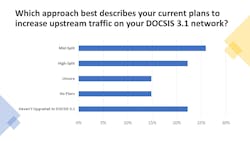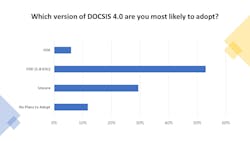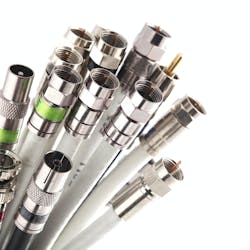Cable operators globally face the challenge of ensuring enough spectrum in their hybrid fiber/coax (HFC) plant to keep ahead of customer bandwidth demands. Particularly with an increasing emphasis on meeting upstream capacity requirements, the question of how best to invest now in spectrum additions, and then how to split that spectrum between upstream and downstream, is an important consideration in network planning. The need to add such capacity in the context of additional network evolutions, such as the move to Distributed Access Architecture (DAA) while prepping for DOCSIS 4.0, can complicate such planning as well.
Broadband Technology Report presented the panel “Where Do DOCSIS Cable Networks Stand Now?” as part of the High Speed Networking 2.0 online conference it produced in early June 2021 with sister site Lightwave. The session gathered representatives from industry and the cable operator community to discuss such issues as mid-split versus high-split for the upstream, extending downstream frequency limits to 1.8 GHz (perhaps in steps), and the current state of DAA deployments.
Splitting the difference
In North America, cable operators typically have run their DOCSIS networks with the 5 MHz to 42 MHz band devoted to upstream traffic. (In Europe, operators often extend this band to 65 MHz or more.) Current network upgrade plans, in particular within the context of the bandwidth spikes encountered during the COVID-19 pandemic, a move to either a mid-split (5 MHz to 85 MHz) or high-split (to 204 MHz) architecture. Of course, that additional spectrum has to come from somewhere and, rather than eat away at their downstream resources, operators frequently pair the addition of these upstream split architectures with additional downstream spectrum.
How far to go towards 1.8 GHz may depend on whether an operator feels more comfortable with mid-split or high-split. So far, mid-split appears more popular among North American and Latin American operators, according to panelist Jay Lee, chief technology and strategy officer, broadband access at ATX Networks. “It is abundantly clear that mid-split type activities are in motion or soon to happen and high-split seems to be either around the corner for some folks who are already starting mid-split or some folks who are waiting to jump into the high-split game,” he commented during the session. “There are a few issues associated with high-split that need to be sorted out. It’s a little bit more challenging of a move that has to do with legacy setup boxes. There are leakage issues that need to be addressed. But that’s an issue that is being addressed at the MSO level and at the CableLabs level.”
Jeff Finkelstein, executive director of advanced technology at Cox Communication, reported during the session that his company has extended the downstream frequency of 85% of its HFC infrastructure to 1 GHz – with the ability to move readily to 1.8 GHz as well. So Cox has some flexibility as it decides which avenues to pursue. “It’s like a buffet,” he commented.
In practice, Finkelstein envisions Cox using both mid-split and high-split, as a particular infrastructure and market require. “We’re in the process of moving towards mid-split into some portion of our plant because we have this immediate upstream challenge that has been brought on by work-from-home, school-from-home, home healthcare, all those things that are most important to customers,” he explained. Meanwhile, “we will be moving towards a high-split/1.2 [GHz extension] in a portion of the plant…. There will be a much larger portion that we would do a high-split/1.2 in because that buys us quite a few years,” Finkelstein continued.
At the same time, Cox will ready the plant for further evolution. “While we’re doing this and probably while we’re doing some of the mid-split, we will be putting in 1.8-gig passives, 1.8-gig-capable actives, with a diplexer we can take from an 85 to 204, 396 [MHz], maybe 492 [MHz],” Finkelstein continued. “There are lots of options as we go forward in this. This sets us up for having the nodes that are capable of ESD [Extended Spectrum DOCSIS]. We’ll have amplifiers that are capable of these different splits. We’ll already be ready and opportunistically, from a success basis, we can undertake moving from where we are today to this sort of intermediate step, which then gets us even further along.”
Finkelstein envisions many of his fellow operators following a similar path – one that will take several years to navigate. “This is going to be the same kind of journey,” he said. “There’s going to be some mid-split. There’s going to be probably more high-split. There’s going to be ultra-high-splits or FDX. This is over a long period of time. So, it’s really almost unfair to say, ‘Are we going to do more mid-split or more high-split?’ Because the answer is, yes, we’re going to be doing both.”
How widely distributed will DAA be?
The roll out of mid-split and high-split capabilities at Cox comes within the context of the operator’s deployment of DAA infrastructure. Finkelstein revealed during the session that Cox has deployed nearly 10,000 Remote PHY devices. However, not many operators, particularly in North America and Latin America, are as far along.
“We have to appreciate that Cox has been a pioneering MSO moving DAA and Remote PHY to real deployments,” commented Hanno Narjus, CEO of Teleste Intercept and senior vice president of one of the joint venture’s parent companies, Teleste. (Antronix is the other parent.) “Whereas we are not seeing that many other MSOs – we’re talking about 5, 10, something like that – who really seem to be rolling out DAA at this point in time.”
“I think that DAA deployments have been held back for probably two main reasons,” offered Paul Broadhurst, president, founder, and chief executive of Technetix Group Ltd., as part of the panel. “I think, number one, that most operators have quite a lot of legacy set-top boxes and, if you do node-splitting and roll out DAA, there are a lot of difficulties using them to support video, digital video. There are some solutions, but it’s complex.
“I think the other thing certainly is the power dissipation of the first-gen DAA equipment, especially in the U.S. for underground networks and in Europe for equipment in cabinets,” Broadhurst continued. “The heating is a problem. And I think that with Gen 2 products that are much lower power dissipation and obviously will be able to do MACPHY, I think things will really start to move now and in 2022.”
Regaining DAA momentum will be critical for the MSO community, Narjus insisted. “Now I think the heavy lifting has been done. Now I really would encourage that all the MSOs should start to look at what is their evolution path and their roadmap to start deploying DAA because that is the mandatory step to get anywhere on this 10G track,” he said.







